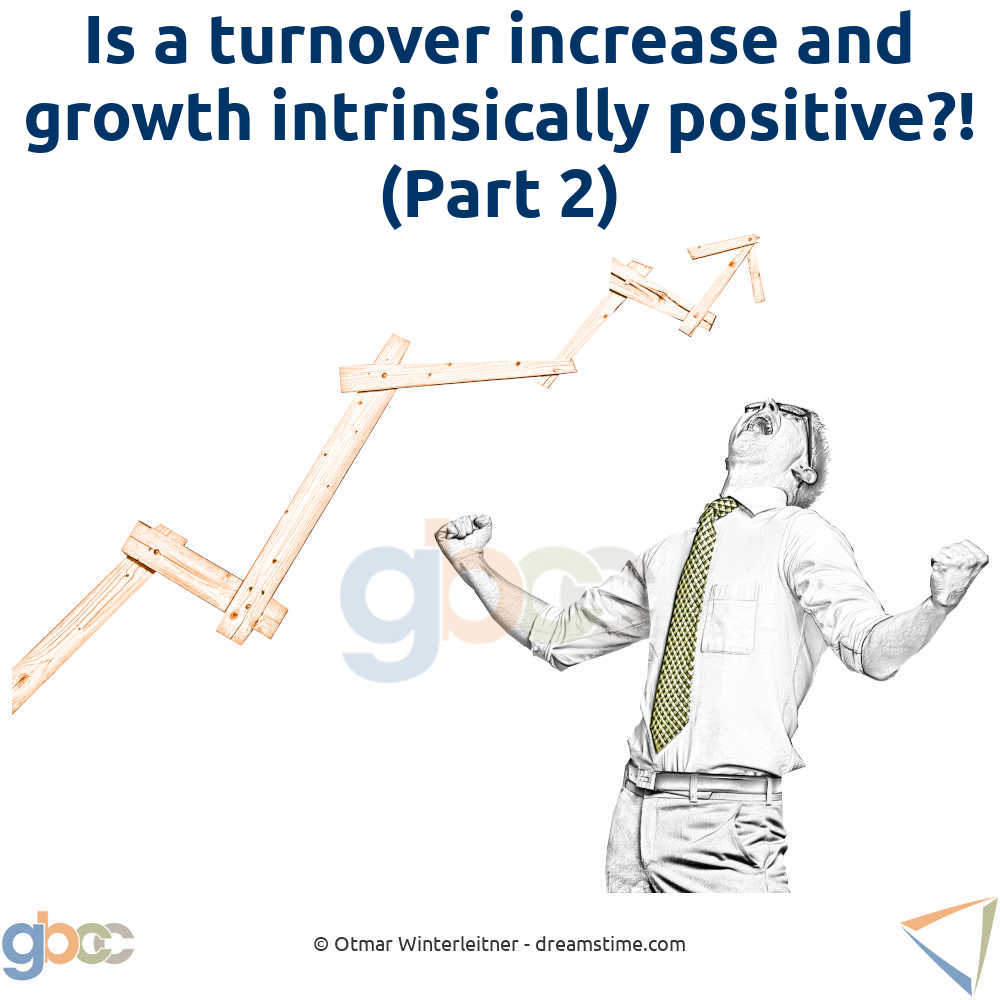Turnover increase and growth: how do you prevent the acquisition of the “wrong” customers and what effect does your marketing statements have on this?
In the first part, we worked out that the usual controlling instruments are insufficient to accompany the implementation of a growth strategy.
- This is because your company is a chain of individual activities between people who interact with each other.
- The duration of many of these activities is usually not fixed, but within a range.
- This range is significantly influenced by the human factor.
Knowing the possible range of internal processes and being able to express it in euros through calculative hourly rates is the be-all and end-all of successful company management and the basis of a successful growth strategy.
Not all customers are the same
But that’s not all. The behaviour of your customers also has a significant influence on this range. To illustrate:
Customer A gives you a clear order, needs no further interactions afterwards and pays on time at the end.
However, customer B
- Wants to have several offers from you,
- Haggles over the price several times,
- Finally awards the contract,
- Still corrects the contract afterwards,
- Always needs constant communication and takes time away from your employees carrying out their tasks,
- Must first be reminded to pay,
- And when you receive payment, you find that they have arbitrarily reduced the invoice.
The problem for almost all companies is that the P&Ls look the same simply because they have the same turnover, and this is despite the difference in behaviour between the types of customers.
Speaking of growth, I came to a sobering realisation that:
As long as you are not able to express this difference in customer behaviour in euros, your company is ultimately flying blind.
Growth: marketing lingo is omnipresent
This problem is, to a large extent, homemade by your company’s marketing and positioning statements.
After all, when companies do marketing, their internal attitude can often be summarised as follows:
„I try to find out what the customer wants to hear from me and then I communicate that accordingly. The main thing is to increase sales.“
If your company is lucky, the customers you don’t want will see the company’s positioning, message and attitude as “pure marketing lingo” and will stay away.
Marketing lingo increasingly attracts the “wrong” customers
However, if your company is unlucky, it will attract many of the “wrong” customers with the intention of increasing sales.
I don’t call them wrong because they do something wrong or have the wrong expectations. Every client has every right in the world to demand what they want from you.
It’s just that they are the wrong customers from your company’s point of view because you have promised your product or service in a way that you ultimately cannot and will not deliver.
And what you actually deliver does not meet your client’s need. A need that you yourself have identified and set for yourself as a benchmark. Your customer remains dissatisfied, keeps nagging, and keeps demanding “more”.
It is precisely this customer behaviour that costs a lot of money.
A practical example
Below is an example (indexed: turnover = €1,000) for the analysis of the economic reality of the business relationship with a key customer:
| Cost allocation as % of turnover | Cost allocation according to actual resources spent | ||
|---|---|---|---|
| Turnover | €1,000 | €1,000 | |
| ( – ) | COGS | €550 | €550 |
| (=) | Gross margin | €450 | €450 |
| ( – ) | Costs | €400 | €600 |
| (=) | Result/total (% of turnover) | €50 (5%) | €– 150 (-15%) |
With only 5% (accounting) profit margin, you might still think: “As long as I’m still in the black, everything is fine because I can advertise with the name of this major customer and win more customers.”
Would you say that even if you were dealing with an economic loss of 15%? The answer is usually “No”! Because, for many entrepreneurs, the fun stops when they have to pay for it out of their own pocket!
Customers looking to waste time tie up disproportionately high resources. When increasing turnover, you should therefore bear in mind that the wrong customers ensure that you will need more and more employees so that you can cope with the resulting extra work. This reduces the profitability of your company.
Your organisation becomes more and more fragile over the years and reacts more and more severely to new entrepreneurial mistakes.
Growth: how do you determine future staffing needs?
As far as growth is concerned, if you were to go the route of recording the duration of activity (see Part 1), then you would of course be able to project future staffing needs much more easily and plan ahead.
But since many companies do not do this, it ultimately boils down to the fact that they start with the expansion strategy and suddenly realise:
“Oops, we need more staff!”
New customers have been acquired, new orders have been accepted and you lack the staff to process them properly. Existing employees are asked to work more overtime.
The questions are therefore:
- How will the company develop? Will it be a smooth or chaotic process?
- What impact will this have on the company’s future productivity and profitability?
- As far as a turnover increase and growth are concerned, will it lead to a successful operation, but the patient is unfortunately dead!?
Conclusion:
As long as you are not able to express different customer behaviours in euros by allocating personnel costs according to their actual cause – at least roughly – your company will ultimately be flying blind.
This is exacerbated by the fact that your company is increasingly attracting the “wrong” customers through a marketing message and positioning that is geared towards growth.
It is therefore important that you go down the path of recording the duration of activity to be able to project future staffing needs much more easily and plan ahead.
Now that we have sufficiently gone through the importance of human resources, I would like to turn to the topic of financial resources and liquidity; specifically, debt and equity financing. This is what the third part is about.

